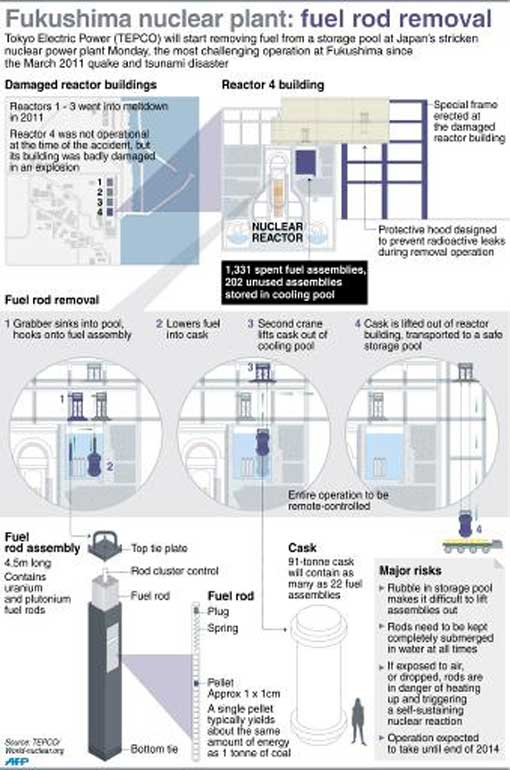You are hereBlogs / WcP.Observer's blog / Why int'l experts not step in? Fukushima, Japan: 1,331 used fuel rods =14,000 x atomic bomb on Hiroshima
Why int'l experts not step in? Fukushima, Japan: 1,331 used fuel rods =14,000 x atomic bomb on Hiroshima


(quote)
Fukushima, Japan. Highly dangerous and unprecedented removal of highly radioactive nuclear fuel rods begins on Nov18
The fuel assemblies are in a 32 x 40 feet concrete pool, the base of which is on the fourth story of the damaged reactor building. The assemblies - which contain plutonium, one of the most toxic substances known - are under 23 feet of water.
If the fuel rods - there are 50-70 in each of the assemblies, which weigh around 661 pounds and are 15 feet long - are exposed to air or if they break, catastrophic amounts of radioactive gases could be released into the atmosphere.
The 1,331 used fuel rod assemblies contain radiation equivalent to 14,000 times the amount released in the atomic bomb attack on Hiroshima.
“Full release from the Unit-4 spent fuel pool, without any containment or control, could cause by far the most serious radiological disaster to date,” say independent consultants Mycle Schneider and Antony Froggatt in a recent World Nuclear Industry Status Report.
28 Signs That the West Coast Is Being Absolutely Fried with Nuclear Radiation from Fukushima
...
8. One test in California found that 15 out of 15 bluefin tuna were contaminated with radiation from Fukushima.
9. Back in 2012, the Vancouver Sun reported that cesium-137 was being found in a very high percentage of the fish that Japan was selling to Canada...
• 73 percent of mackerel tested
• 91 percent of the halibut
• 92 percent of the sardines
• 93 percent of the tuna and eel
• 94 percent of the cod and anchovies
• 100 percent of the carp, seaweed, shark and monkfish
12. BBC News recently reported that radiation levels around Fukushima are “18 times higher” than previously believed.
13. An EU-funded study concluded that Fukushima released up to 210 quadrillion becquerels of cesium-137 into the atmosphere...
15. At this point, 300 tons of contaminated water is pouring into the Pacific Ocean from Fukushima every single day.
"Fukushima is the most terrifying situation that I can imagine," prominent Japanese-Canadian scientist David Suzuki said, adding that another earthquake could trigger a potentially catastrophic, nuclear disaster. A future earthquake could trigger a disaster that would decimate Japan and affect the entire West Coast of North America, a prominent scientist has warned. Speaking at a symposium on water ecology at the University of Alberta in Canada, David Suzuki said that the Japanese government had been “lying through its teeth” about the true extent of the 2011 Fukushima nuclear disaster.
“The fourth [reactor] has been so badly damaged that the fear is if there’s another earthquake of a 7 or above then that building will go and all hell breaks loose,” he said, adding that the chances of an earthquake measuring 7 or above in Japan over the next three years were over 95 percent.
“If the fourth [reactor] goes under an earthquake and those rods are exposed, then it’s bye, bye, Japan and everybody on the west coast of North America should be evacuated. And if that isn’t terrifying, I don’t know what is,” Suzuki said.
Japan lawmaker reprimanded after emperor letter on Fukushima nuclear disaster
Taro Yamamoto, an independent lawmaker, drawing heavy criticism in Japan, by handing the Emperor a letter of concern over the issue of the growing Fukushima radiation and the impact on children’s health. Taro Yamamoto at the Tokyo prefecture in the House of Councilors, the upper house of the Japanese parliament, personally handed the letter to Emperor Akihito during a party at the Akasaka Palace’s imperial garden on Thursday. He said that he wanted to inform the Emperor “directly” of the crisis at the Fukushima nuclear plant north of Tokyo. The Tohoku earthquake that hit off Japan’s Pacific coast in March 2011 triggered a tsunami that damaged nuclear reactors at the Fukushima Daiichi. Since then the plant has been leaking radioactivity leading to the evacuation of more than 150 000 people. The land surrounding the plant has been off-limits due to high radiation that can cause cancer and other health problems.
Emperor and atomic bomb
Japan was doing basic research on the atomic bomb. However, according to one Japanese source, Hirohito was opposed to the atomic bomb plan from the beginning. The Emperor thought that use of an atomic bomb would bring about the extermination of mankind. The Navy (F-go) and Army (Ni-go) atomic bomb research projects were in operation until the end of World War II. The Ky?j? Incident was an attempted military coup d'état in Japan at the end of the Second World War. It happened on the night of 14 August 1945 – 15 August 1945, just prior to announcement of Japan's surrender to the Allies. The attempted coup was put into effect by the Staff Office of the Ministry of War of Japan and by many from the Imperial Guard of Japan in order to stop the move to surrender.
After several more days of behind-the-scenes negotiations and a failed coup d'état, Emperor Hirohito gave a recorded radio address across the Empire on August 15. In the radio address, called the Gyokuon-h?s? ("Jewel Voice Broadcast"), he announced the surrender of Japan to the Allies.
Politician draws Japanese Emperor into out-of-control nuclear leak disaster (TOKYO — Reuters, Published Friday, Nov. 08 2013) A Japanese lawmaker was reprimanded on Friday for breaking a taboo by trying to involve Emperor Akihito in politics when he handed him a letter expressing concern about the health impact of the Fukushima nuclear crisis.
A furore erupted after Taro Yamamoto gave Akihito the handwritten missive at a garden party last week, the first such bid in more than a century to draw the emperor’s attention.
(unquote)
Image courtesy TEPCO / AFP / File, AFP Graphic


















